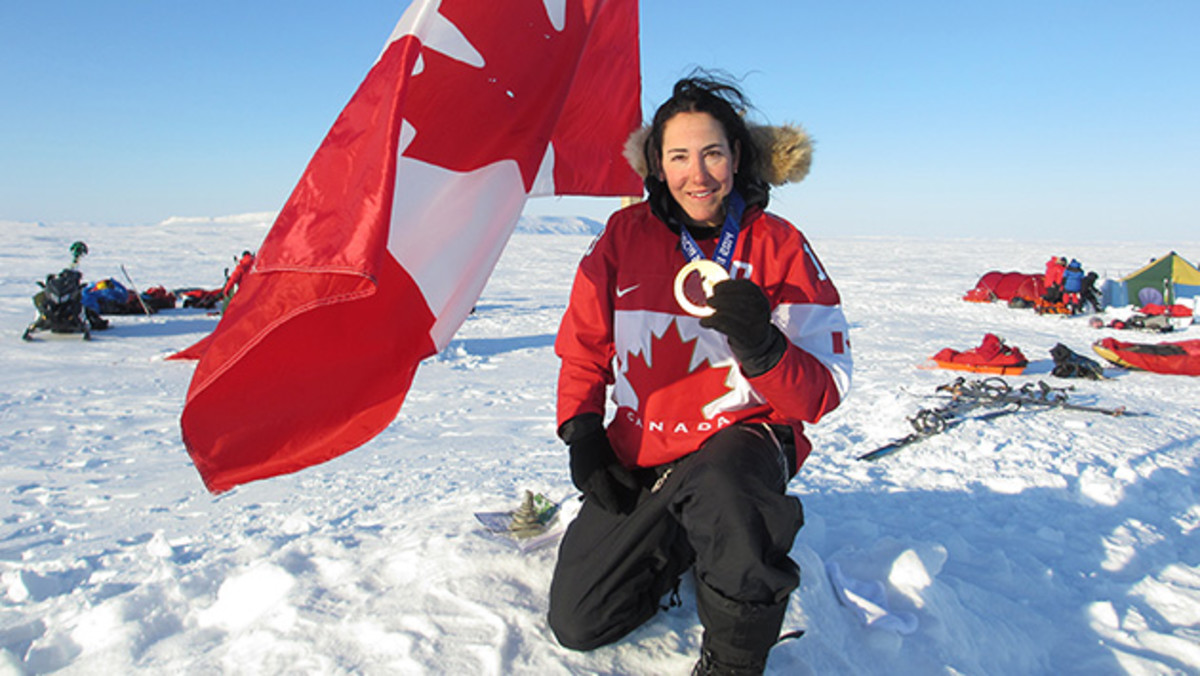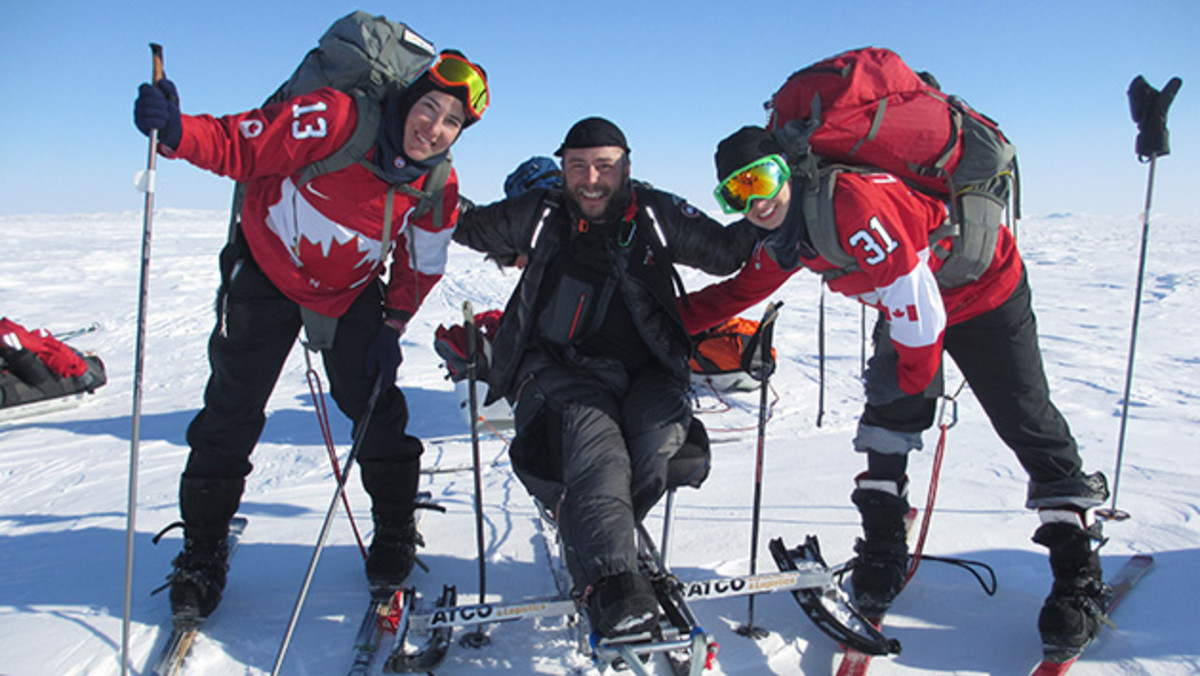Trip to North Pole a true Canadian moment for Lacasse, Ouellette

Some aren't content when they master one task. They instead seek out constant challenges and goals to work toward.
Such is the case with Caroline Ouellette and Genevieve Lacasse, two members of the gold-medal winning women's ice hockey team during the 2014 Olympic Games in Sochi.
After hard-fought games that brought them the highest honor in women's hockey, the pair returned home and took on one more physical and mental trial: skiing to the North Pole.
An organization called the True Patriot Love Foundation had put together the largest skiing expedition to the North Pole in March of 2014 in an attempt to raise money for Post-Traumatic Stress Disorder research. The expedition would leave from Resolute Bay, a small aboriginal town in Nunavut, Canada, and would involve dropping off Bauer hockey equipment at the town. Following that, the participants, a mix of CEOs, soldiers and two Team Canada athletes, would ski 120 km (approximately 75 miles) over the course of six days before reaching the top of the world.
Small victories helping Blades’ Lacasse star amid trying season
Neither Lacasse, 26, nor Ouellette, 36, were originally supposed to take part. The first invitee was Hayley Wickenheiser, a teammate on Team Canada. Wickenheiser, however, had broken her foot before the Sochi Games and so trip organizer Paul Desmarais III extended the offer to Ouellette instead. Ouellette invited Lacasse along when the expedition was looking for bilingual athletes to join in.
Lacasse, a goalie who terms herself a “military brat,” was thrilled, not just to ski to the north pole, but to raise money for military personnel simultaneously.
“I think I replied to the email and then I was just so excited I called her,” Lacasse laughed. “I was like, ‘Yes, yes, yes! I'm so excited right now!’”
The two accepted and began preparations for yet another test of their mental and physical perseverance.
“My teammates all thought I was crazy because I am always freezing,” Ouellette said. Known to her teammates as “Grandma”––or “Grandmére”––the Montreal-born forward always has wool socks and is bundled up like it's -30 Celsius, by her own admission.
“When we’re on a plane overseas Caro has toque on, an eye mask, she pulls her toque over her nose and she wears gloves to stay warm on a plane,” Lacasse said. “ It's kind of funny. But she was a trooper. She stayed warm the whole time.”

“[Braving the cold] was quite a personal challenge for me but that's exactly how I saw it, being part of something that had never been done,” said Ouellette.
Lacasse and Ouellette had only a month to prepare for the trip, and just one short trip to the home of one of the expedition leaders to nail cross-country skiing. Ouellette hadn't cross-country skiied since she was six years old and Lacasse, though she had a bit more recent experience, wasn't in much better shape, skill-wise.
"We kind of didn't know what we were getting into,” said Lacasse.
Darkangelo savoring her journey with U.S. National Team
They soon found that the skiing, though not easy, wasn't the biggest obstacle they would have to overcome. Instead, it was the subzero temperatures.
"The first night was such a challenge,” Ouellette said. “We were so cold.”
Before the first day of their journey, the hockey players had asked, just in case, what the rescue options were in case of injury. They were told it would cost approximately $10-15,000 Canadian to airlift someone out. It was feasible, but only in the most dire of circumstances. Quitting, they were told, was not an option at this point.
That first night, in their private tent inside a larger pod that was only five degrees Celsius warmer than the minus-35 chill outside, they got very little sleep.
"We were laying in our tent yelling out, ‘Come rescue us, we pay cash!’” Lacasse said, jokingly.
“It made us laugh, made the situation a little less tense to start screaming that, ‘When can we get the helicopter! We need to raise money!’” Ouellette said, imitating her teammate in a raised voice. “We were quite miserable the first night. We were freezing, we were so cold. That's a moment I'll never forget.”
“That was probably the hardest part, the first two or three nights, trying to figure out how to stay warm in your sleeping bag at night,” Lacasse added. “It was just Caro and I, freezing. ‘Are you sleeping yet?’ ‘No. Are you?’ And then if you have to pee, you're all bundled up: you're screwed.”
Amanda Kessel’s next chapter will include a quest for gold
“It got better as we learned some tricks,” Ouellette said. “The Nalgene bottle [turned into a makeshift hot water bottle] was the best one, and just, you know, layers and layers [of clothes]. Gen and I would kind of run around our tent for a few minutes before going to bed.”
Ouellette learned it wasn't the sleeping bag keeping her warm, but her own body heat, so she had to generate as much as she could—but carefully.
Throughout the expedition it was stressed to each participant that they absolutely could not sweat. In temperatures such as the ones they faced, sweating meant freezing to death shortly afterwards.
The pair picked up all sorts of new skills, ranging from cutting snow blocks to build a wall around the tent that would keep the wind from whistling through the tent at night, to how to prepare dehydrated food, warming it with just their body heat.

Both adjusted well. Ouellette, the grandmother, donned a neck-to-toes ski suit that kept her warm and inspired Michelin Man jokes from Lacasse. Both made friends with the others on the expedition, in particular Bjarne Nielsen, a soldier who had lost part of a leg to an IED in Afghanistan and completed the majority of the journey on sled. On the final day of the trip, Nielson left them all in the dust as they reached the magentic North Pole.
“It was him out in front, and behind him was the lineup of soldiers and behind them was everyone else,” Lacasse said. “It was lucky we were all wearing ski goggles because everyone was tearing up. I was crying pretty hard; it was a powerful moment when he planted that Canadian flag there. Everyone was cheering and then we all got together and sang the Canadian national anthem. It was such a Canadian moment.”
Somehow, the pair of hockey players found a way to make it even more Canadian by donning their Team Canada jerseys and breaking out the gold medals for a photo opportunity. It was a picture-perfect moment, and hard-won.
Would they do it again, going through the cold and tiring trek?
Marie-Philip Poulin, Leslie Oles excel as CWHL neo-rookies
“Absolutely,” Ouellette said.
“I've been so fortunate to have the journey that I've had in sports, and, you know, finding a passion and being able to represent Canada,” she said, soberly. “You know, it really strikes with me how Canadian athletes with gold medals, we're seen as heroes in our country but the real heroes are the military men and women who sacrifice so much and risk their lives in military missions. I feel like most of the time we don't give them the credit they deserve and certainly the support they need to re-integrate after missions.”
Lacasse agreed, but added, “For me, I took away that my limits can be pushed a lot further than I had ever imagined.
“When you're there, hockey doesn't matter. Nothing but that mattered at that moment. I was so proud of being a Canadian, being a part of that group,” Lacasse said. "We made history that day.”
